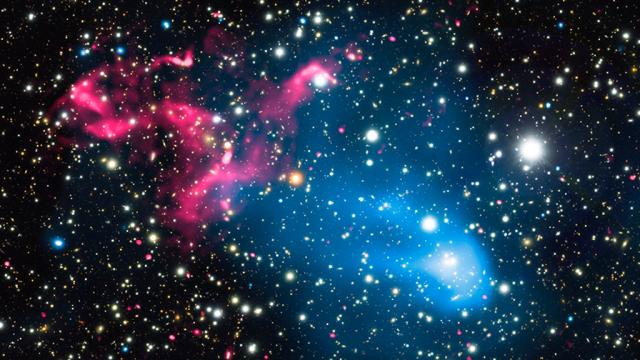Two billion light years away, two clusters of galaxies are colliding in an intergalactic pileup. As black holes interact with the gas inside the collision, the mass has turned into an enormous particle launcher, spewing some of the universe’s highest-energy stuff.
Image: X-ray: NASA/CXC/SAO/R. van Weeren et al; Optical: NAOJ/Subaru; Radio: NCRA/TIFR/GMRT
The picture above shows a couple of different processes happening at the same time to create the intergalactic bazooka. The blue section, taken by the NASA’s Chandra X-ray Observatory orbiting the Earth, shows X-ray emissions from colliding galactic clusters. The largest structures in the universe bound by gravity, each is a quadrillion times heavier than the Sun, according to a Chandra press release. The fuzz shows hot gas that fills each cluster, and the collision causes particles to travel faster than the gas travelling at the speed of sound — already much higher than the speed of sound on Earth because of its high heat. This creates shock waves, kind of like the ones that come off fighter jets.
The red section, taken by the Giant Metrewave Radio Telescope array in India, shows radio wave emissions from the supermassive black holes at the centre of galaxies that appear as the bright pink blobs. The fun happens when the black holes and the hot gas interact. Scientists already knew that supermassive black holes accelerate the particles out of the cloud that orbits them, but when those accelerated particles meet the shock wave, they’re boosted again as if they passed through one of those foam Hot Wheels turbochargers. The scientists showed the results at the 229th meeting of the American Astronomical Society in Grapevine, TX and published these observations in the inaugural issue of Nature Astronomy Wednesday.
“This is the first time we’ve seen this double acceleration,” Reinout van Weeren, Harvard astrophysicist and the study’s first author, told Gizmodo. “First in the black hole and then in the shock.”
Having a giant space accelerator means that there could be unobserved particles created in space, the same way scientists needed the high energy of the world’s largest particle accelerator, the Large Hadron Collider, to observe the Higgs Boson. “Potentially these accelerators can reach energies much higher than the LHC, maybe a million times more,” said van Weeren.
Scientists don’t (and will probably never) have the tools to observe the specifics of what’s going on two billion light years away, but van Weeren is still excited about how new technology will soon allow astronomers to better observe these particle accelerators. Ultimately, it’s “just very cool,” said van Weeren, “because we can’t reach these energies on Earth. Maybe in the future we can learn how to accelerate to even higher energies than the LHC.”
